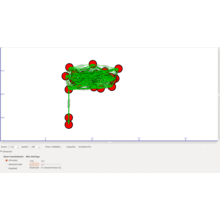Tag Archive: 'ns3 tutorial'
In this position paper, we propose an unobtrusive solution for improving bonding relations between the elderly and their caregivers, through the Social Hue. The Social Hue is a bidirectional application that is based on the Philips Hue light. To create social presence, activity and emotional states will be detected through sensors and will be transformed into ambient lighting into the elder’s home and […]
The growing size of cities and increasing population mobility have determined a rapid increase in the number of vehicles on the roads, which has resulted in many challenges for road traffic management authorities in relation to traffic congestion, accidents, and air pollution. Over the recent years, researchers from both industry and academia have been focusing […]
Although previous bio-inspired models have concentrated on invertebrates (such as ants), mammals such as primates with higher cognitive function are valuable for modeling the increasingly complex problems in engineering. Understanding primates’ social and communication systems, and applying what is learned from them to engineering domains is likely to inspire solutions to a number of problems. This paper […]
A smart city aims to improve urban functions and provided services, being often perceived as a living urban fabric, in which connected urban citizens, acting as active sensors, have the capacity to contribute even more efficiently to the spatial intelligence of cities. This “immaterial” dimension is related with the need that smart cities have to assess […]
User-contributed or crowd-sourced information is becoming increasingly common. In this paper, we consider the specific case of participatory sensing whereby people contribute information captured bysensors, typically those on a smartphone, and share the information with others. We propose a new metric called quality of contributed service (QCS) which characterizes the information quality and timeliness of […]
A desired capability in military operations is the reliable and efficient sharing of Situational Awareness (SA) data at the tactical edge network. Many implementations of SA sharing in the literature use frequent broadcasts of SA messages in order to provide an up-to-date and comprehensive operating picture to all nodes. However, SA sharing may result in […]
This paper describes the Flexible Internetwork Stack (FINS) Framework, an open-source tool to enable implementationbased experimental research in computer networking. The FINS Framework uses a module-based architecture that allows cross-layer behavior and runtime reconfiguration of the protocol stack. The FINS Framework is general enough to enable experimental setups under various network architectures (e.g., MANET, infrastructure, mesh) […]
With the advent of wireless communication networks and the new generation of smartphones, the access to data transmission networks has become possible anywhere at any time. Today, a group of users can gather in a dynamic manner and set up their own ad hoc communication networks and share geolocalization information thought Global Position System (GPS). […]
Mobile Adhoc networks are gaining popularity in today’s dynamic environment. These are characterized by high mobility, infrastructureless, self organizing, quick deployability and resource constrained networks. The network depends on cooperation among nodes for any communication. High mobility and dynamic architecture of mobile adhoc network make it vulnerable to security issues. Trust plays an important role […]
The Virtual Node Layer (VNLayer) is a clusterbased approach to handle communications in mobile ad-hoc networks (MANETs), furnishing an abstraction of fixed geographical regions served by virtual nodes as a means to tackle the challenges raised by the mobility of the physical nodes. Several studies have proved that the VNLayer constructs can be applied to […]

 Click Here to watch our latest output video using NS3 simulator
Click Here to watch our latest output video using NS3 simulator  Click Here to watch our latest projects screenshots using NS3 simulator
Click Here to watch our latest projects screenshots using NS3 simulator